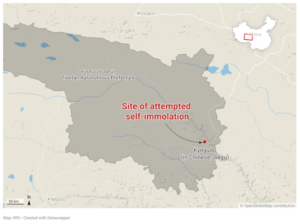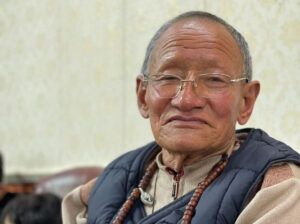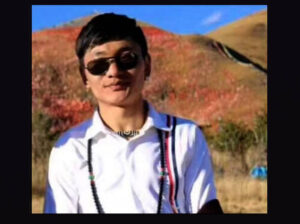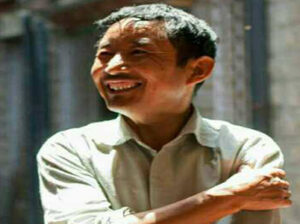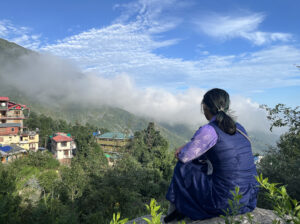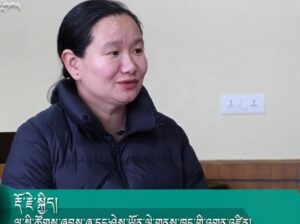
Michael with His Holiness the Dalai Lama
Photo: Michael Buckley
Michael Buckley’s many years researching Tibetan issues has led to the publication of three new books. Here he speaks to Contact about his involvement with Tibet.
Contact: Tell us briefly about yourself – your background, interests
Michael Buckley: I am a very curious person with a wide range of interests. That is what has led me to travel to many countries around the world, usually with research and writing purposes in mind. I am, for instance, a keen scuba-diver, and concerned with preserving the world’s oceans, which are under great threat.
C: How did you become involved with Tibet and Tibetans?
MB: I wrote a guidebook to China for Lonely Planet in the early 1980s. One place that was off-limits to foreign visitors at the time was Tibet. But then Tibet suddenly opened in 1985 and I travelled across Tibet to research and write the first English guidebook to Tibet for Lonely Planet, published back in 1986.
C: What came first, your interest in the environment or your interest in Tibet?
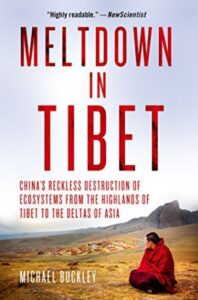 MB: Guidebook writing requires repeated visits to update the practical details, and it was during these visits that I started to notice the landscape of Tibet itself was changing, which is something you never expect to happen. The snowcapped mountains, the grasslands, the rivers—were undergoing drastic changes. So then I worked on a short documentary, Meltdown in Tibet. And later wrote a book of the same title. That is a different kind of guide work—a guide to on-going environmental disaster.
MB: Guidebook writing requires repeated visits to update the practical details, and it was during these visits that I started to notice the landscape of Tibet itself was changing, which is something you never expect to happen. The snowcapped mountains, the grasslands, the rivers—were undergoing drastic changes. So then I worked on a short documentary, Meltdown in Tibet. And later wrote a book of the same title. That is a different kind of guide work—a guide to on-going environmental disaster.
C: What inspired you to write your current book on the Tibetan environment? How did it happen?
MB: I wanted to inspire readers with quotations from His Holiness the Dalai Lama on environment, matched to photos of Tibet’s majestic 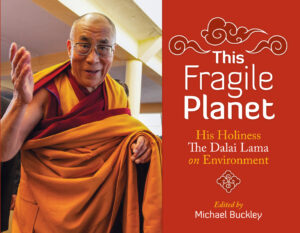 landscapes. His Holiness has long been involved in environmental issues, as one of his lifelong commitments is preservation of Tibetan culture and environment. What fascinated me is that Tibetans have had a concept of sacred landscape for over a millennium, far in advance of the West. Nature and all sentient beings are held in high regard by Tibetans—which could well be a solution to dealing with the current situation with climate chaos and ecosystem collapse. I contacted a dozen professional photographers to get them on board for this project, and liaised with the office of His Holiness to obtain photos of himself. The resulting book is This Fragile Planet: His Holiness the Dalai Lama on Environment, published in September.
landscapes. His Holiness has long been involved in environmental issues, as one of his lifelong commitments is preservation of Tibetan culture and environment. What fascinated me is that Tibetans have had a concept of sacred landscape for over a millennium, far in advance of the West. Nature and all sentient beings are held in high regard by Tibetans—which could well be a solution to dealing with the current situation with climate chaos and ecosystem collapse. I contacted a dozen professional photographers to get them on board for this project, and liaised with the office of His Holiness to obtain photos of himself. The resulting book is This Fragile Planet: His Holiness the Dalai Lama on Environment, published in September.
C: How do you research your books? Do you go to Tibet?
MB: I mounted a number of trips and expeditions to Tibet between 1985 and 2015. I have also visited many Tibetan Buddhist enclaves such as Mongolia, Bhutan, Nepal and Himalayan India (Sikkim and Ladakh). Research is a mix of boots-on-the-ground, interviews with experts and key witnesses, and desk (internet) research. But you have to be careful with internet research as so many sources are just plain misleading or wrong. On-the-ground research is very valuable because it allows me to figure out what rings true in the many research sources consulted.
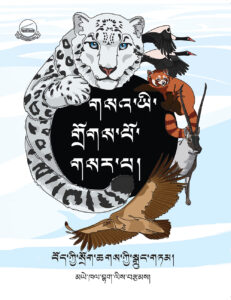
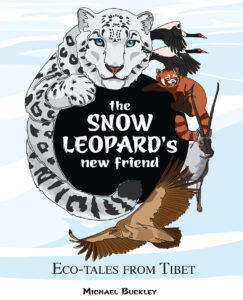 Also published in September is The Snow Leopard’s New Friend, a children’s book that I wrote about the fabulous animals of Tibet. I was surprised how little has been written about the unusual animals of Tibet such as the wild yak, the Tibetan sand fox and the takin (the takin is a species of goat-antelope). So I set out to trace some of these animals, mounting an expedition to find the takin in Bhutan. We found that takins only gather in numbers during the monsoon season, and nobody treks in the monsoon because of leeches and other biting bugs at lower elevations. So we decided to do just that, and found a large group of wild takins frolicking in the highlands. En route, we found the fabled blue poppies of Bhutan, a beautiful bonus. They only flower in the early monsoon season.
Also published in September is The Snow Leopard’s New Friend, a children’s book that I wrote about the fabulous animals of Tibet. I was surprised how little has been written about the unusual animals of Tibet such as the wild yak, the Tibetan sand fox and the takin (the takin is a species of goat-antelope). So I set out to trace some of these animals, mounting an expedition to find the takin in Bhutan. We found that takins only gather in numbers during the monsoon season, and nobody treks in the monsoon because of leeches and other biting bugs at lower elevations. So we decided to do just that, and found a large group of wild takins frolicking in the highlands. En route, we found the fabled blue poppies of Bhutan, a beautiful bonus. They only flower in the early monsoon season.
C: How can ordinary people, especially Tibetans, contribute to the protection of Tibet’s fragile ecosystem?
MB: Within Tibet, that is going to be very difficult because of China’s draconian rule and because China does not care about environmental issues, as their engineers are involved in building megadams and extensive mining on the plateau to exploit these resources. However, in places like Bhutan, Sikkim and Ladakh, dramatic solutions have been implemented to stall ecosystem collapse. In Ladakh, ice stupas have been introduced that replicate the work of glaciers. And Ladakh has introduced vast solar farms as energy sources. In Bhutan, over 50 percent of the land area has been set aside for national parks and nature reserves, even a park for the Yeti. Ordinary people need to develop a healthy respect for nature, and leave nature to work its magic, unhindered by human interference. There are solutions if we are dedicated to seeing them through.
Michael’s books are published published by Sumeru Books, and the children’s book The Snow Leopard’s New Friend is available in Tibetan from the Library of Tibetan Works and Archive.




 Print
Print Email
Email